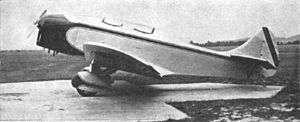IAR-22
| IAR-22 | |
|---|---|
 | |
| IAR-22 | |
| Role | Basic trainer |
| National origin | Romania |
| Manufacturer | Industria Aeronautică Română (IAR), Brasov |
| First flight | c.1934 |
The IAR-22 was a single engine basic trainer built in Romania in about 1934. It was a low-wing monoplane with two seats in tandem and a fixed conventional undercarriage.
Design
The IAR.22 was a wooden, low-wing monoplane with a fixed conventional undercarriage, seating two in tandem, open cockpits. The wings were built around two spruce box spars, with plywood webs; plywood covered the whole wing except for the fabric trailing edges. In plan, the wings were straight-tapered, with most of the taper on the trailing edge, but with rounded tips. The wing trailing edge carried ailerons but no flaps. The tailplane was also straight-tapered, though with the taper more equally distributed between leading and trailing edges. The elevators were split, with a cut-out for rudder movement, and were horn balanced. The fin was also straight-edged but the broad rudder, also horn balanced, had a curved trailing edge.[1]
The fuselage of the IAR.22 was flat sided, tapering to the rear. It was a Warren truss structure with duralumin gussets; the forward fuselage was plywood covered, the remain fabric clad. Rounded decking, together with a head fairing behind the rear cockpit, gave the aircraft a slightly humped profile. The front cockpit was just behind the leading edge of the wing and the rear one at mid-chord. The nose line dropped slightly over the cowling of the 97 kW (130 hp) de Havilland Gipsy Major engine, an inverted air-cooled inline engine carried on a steel mounting and which drove a two-bladed propeller. The undercarriage had a wide track of over 2.5 m (100 in), with near perpendicular IAR-made shock absorber legs, split axles hinged at the fuselage centre line and trailing struts. The wheels had independent brakes but were not faired in.[1]
It was reported that the IAR.22 "gave very satisfactory results in tests" conducted by the Romanian Air Ministry's Acceptance Commission[1] but there is no record of its adoption by the Romanian Air Force. The design allowed for engines of up to 225 kW (300 hp) to be fitted: the intention was that it should be suitable for wireless, camera and gunnery training.[1]
Specifications
Data from Jane's all the World's Aircraft 1937[2], Romanian Aeronautical Constructions 1905–1974[3], Flight 1934[1]
General characteristics
- Crew: 2
- Length: 7.52 m (24 ft 8 in)
- Wingspan: 11.53 m (37 ft 10 in)
- Height: 2.02 m (6 ft 8 in)
- Wing area: 20.8 m2 (224 sq ft)
- Empty weight: 647 kg (1,426 lb)
- Gross weight: 880 kg (1,940 lb)
- Powerplant: 1 × de Havilland Gipsy Major 4-cylinder inverted air-cooled inline piston engine, 97 kW (130 hp)
- Propellers: 2-bladed fixed-pitch propeller
Performance
- Maximum speed: 193 km/h (120 mph; 104 kn) at sea level
- Stall speed: 73.73 km/h (46 mph; 40 kn)
- Range: 550 km (342 mi; 297 nmi)
- Service ceiling: 5,200 m (17,100 ft) service ceiling; 6,000 m (20,000 ft) absolute ceiling
- Rate of climb: 3.3 m/s (650 ft/min)
- Time to altitude: 1,000 m (3,300 ft) in 5 minutes 7 seconds
- 2,000 m (6,600 ft) in 11 minutes 6 seconds
- 3,000 m (9,800 ft) in 19 minutes 56 seconds
- 2,000 m (6,600 ft) in 11 minutes 6 seconds
- Wing loading: 42.3 kg/m2 (8.7 lb/sq ft)
- Power/mass: 0.1103 kW/kg (0.0671 hp/lb)
References
| Wikimedia Commons has media related to IAR Braşov. |
- 1 2 3 4 5 "A Romanian Trainer: The IAR 22". Flight. XXVI no. 11 (1316): 252–253. 15 March 1934. Retrieved 19 April 2018.
- ↑ Grey, C.G.; Bridgman, Leonard, eds. (1937). Jane's all the World's Aircraft 1937. London: Sampson Low, Marston & company, ltd. p. 255c.
- ↑ Gugju, Ion; Gheorghe Iacobescu; Ovidiu Ionescu. Romanian Aeronautical Constructions 1905–1974. Brasov. p. 158-159.